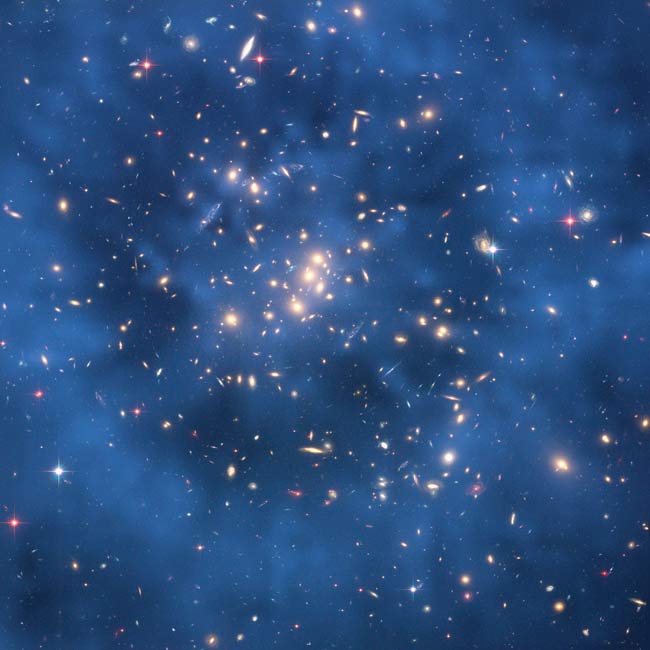Astronomers Nab $500,000 Prize for Hunting Elusive Dark Matter

Dark matter is thought to be all around us, yet scientists can't see it, touch it, or even figure out what it is.
Now four astronomers who helped befuddle the world by discovering evidence for dark matter have won a prestigious cosmology prize. Scientists infer the existence of dark matter by its gravitational influence on the regular, visible matter around it.
The scientists will share the $500,000 purse that comes with the 2011 Cosmology Prize of the Peter and Patricia Gruber Foundation.
The winners are: University of California, Berkeley, astronomer Marc Davis; George Efstathiou, the director of the Kavli Institute for Cosmology in Cambridge, England; Carlos Frenk, the director of the Institute for Computational Cosmology at Durham University in England; and Simon White, a director of the Max Planck Institute for Astrophysics in Garching, Germany.
The researchers created key computer simulations more than 20 years ago that mapped the large-scale distribution of matter in the universe. The simulations were enough to convince most experts of the existence of dark matter, and set off a so-far fruitless search to find out what it is.
In 1981, while he was a young professor of astronomy at the Harvard-Smithsonian Center for Astrophysics (CfA), Davis surveyed 2,400 galaxies at various distances, and discovered that the universe wasn't just a uniform scattering of galaxies, but a cosmic web' of galaxies grouped into filaments separated by vast voids. [Video: Dark Matter in 3D]
"At the time, nobody had any idea what the large scale distribution of matter was, and mostly we didn’t think about it," Davis said in a statement. "I soon saw that the best mathematical model of the Big Bang we had was wrong, there was a complete disconnect between our CfA observations and the theory."
Breaking space news, the latest updates on rocket launches, skywatching events and more!
That prompted Davis to team with the other three researchers to produce computer models that conducted vast calculations to simulate billions of years of galaxy evolution.
The team's models showed that a certain type of dark matter — slow-moving particles called cold dark matter — could produce the clumps, filaments and voids observed in space.
"That was the clincher," Davis said. "We said that the universe looks like it is dominated by cold dark matter, and everybody was convinced after that."
While the search for dark matter since then has been frustrating, since no plausible particle responsible for dark matter has yet been detected by scientists, the researchers said the discovery was exhilarating, too.
"Boy, that was just a fun thing to do, we really had a great time, we loved it," Davis said of his collaboration with Efstathiou, Frenk and White, who together were called the DEFW team, or the Gang of Four.
"Nobody yet knows what dark matter or dark energy are," according to a Gruber Foundation statement. "Today the match between observation and theory indicates that the universe is composed of 4.6 percent 'ordinary' matter, 23.3 percent dark matter, and 72.1 percent dark energy. Numerical simulations of the kind pioneered by DEFW show that a universe with this astonishingly precise yet remarkably strange composition does indeed develop structures which are a close match to those we see around us."
Follow SPACE.com for the latest in space science and exploration news on Twitter @Spacedotcom and on Facebook.
Join our Space Forums to keep talking space on the latest missions, night sky and more! And if you have a news tip, correction or comment, let us know at: community@space.com.

Space.com is the premier source of space exploration, innovation and astronomy news, chronicling (and celebrating) humanity's ongoing expansion across the final frontier. Originally founded in 1999, Space.com is, and always has been, the passion of writers and editors who are space fans and also trained journalists. Our current news team consists of Editor-in-Chief Tariq Malik; Editor Hanneke Weitering, Senior Space Writer Mike Wall; Senior Writer Meghan Bartels; Senior Writer Chelsea Gohd, Senior Writer Tereza Pultarova and Staff Writer Alexander Cox, focusing on e-commerce. Senior Producer Steve Spaleta oversees our space videos, with Diana Whitcroft as our Social Media Editor.
